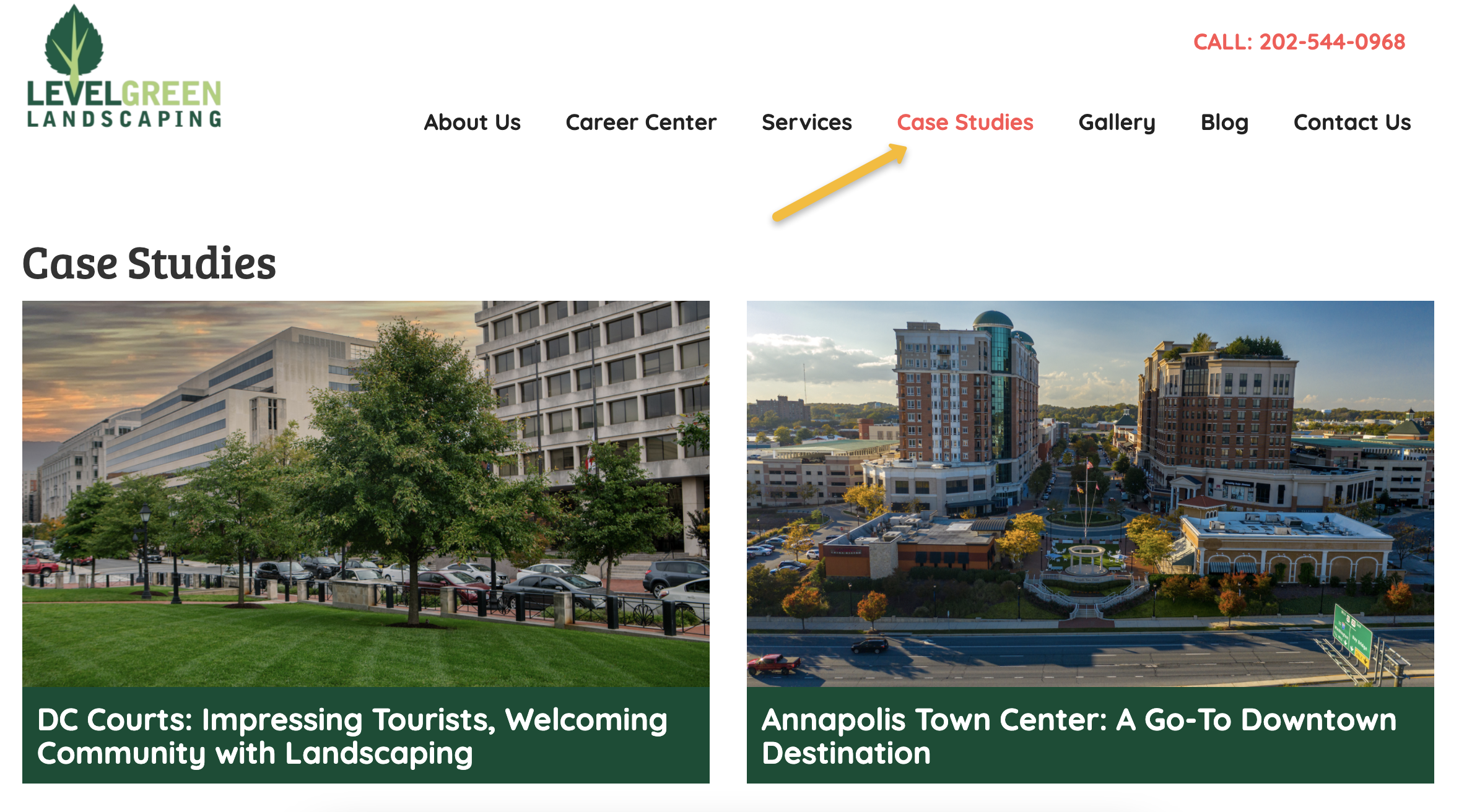Topics: Content Marketing Sales Web Development Public Relations
Making the Case for Case Studies (and How Your Landscaping Company Can Leverage Them for Marketing and Sales)
 Author: Lindsey Getz
Author: Lindsey Getz
One of the most powerful sales tools that you already have available to you is completed projects. But if you’re like a lot of landscape business owners, you might not be taking full advantage of this.
There’s no question that having photos of finished jobs on your website in the form of a portfolio is important. But when it comes to leveraging the power of successful projects, you also want to tell the story behind the project.
The story is where people find connections and relatability—and that is powerful.
In this article, we’ll talk more about why case studies are so important as well as how you can create a great one to help you qualify potential leads.
(ACCESS NOW: Your Guide to a Kick-Ass Commercial Landscaping Website)
What is a Case Study?
As you may have gathered, a case study is more than just pictures. It’s essentially an article that also includes the “story” behind the project that was completed.
It’s helpful when a case study documents how a landscaping company was able to help a customer with a unique problem or challenge. This is a key consideration when determining which projects would make strong case studies. You should think about what pain points or challenges were involved in a project and whether it’s relatively common (or “relatable”) to other potential clients.
As you present the pain points that the customer was experiencing, you can then detail how you were able to solve them. In doing so, the prospect or website visitor can begin to see themselves in your customer’s shoes.
Here is a great example from our client, Level Green Landscaping: Steptoe & Johnson: Rescuing a High-Rise Patio, Nine Floors Up.
 It’s the story behind a high-use patio on the 9th floor of a Washington DC law office which was about to be the location for an annual Fourth of July party with 300+ people. With that party just on the horizon, the patio’s Knock Out Roses display had become infected with Rose Rosette Disease and was dying. The facility manager needed a solution—and fast.
It’s the story behind a high-use patio on the 9th floor of a Washington DC law office which was about to be the location for an annual Fourth of July party with 300+ people. With that party just on the horizon, the patio’s Knock Out Roses display had become infected with Rose Rosette Disease and was dying. The facility manager needed a solution—and fast.
Level Green explains how they were able to add swiftly (in time for the party) and overcome specific challenges like navigating landscaping trucks through the city and getting plant material to the roof.
This story’s themes of overcoming challenges in relation to accessibility and timing are relatable to property managers, even if they don’t work in a high-level building.
Case Studies are More Than Just a “Project Feature”
The idea of including challenges that have to be overcome is really instrumental in the success of case studies. It’s so much more than just a “project feature” or a “project showcase,” in which you’re just “showing off” a project. There can be a place for those, too—like the $300,000 backyard swimming pool renovation that won an NALP award.
Those kinds of projects are more aspirational and can work for residential customers who often buy on emotion.
However, with property managers and B2B sales, simply buying on emotion doesn’t work for them. They need someone who “gets it,” and who can solve their challenges.
And frankly, residential homeowners often feel this way, too. Maybe they have a backyard that is sloped, feels too small, or isn’t getting used enough. These are all pain points that you could play upon in a case study. Case studies can definitely work for both residential-focused and B2B companies.
Case studies also add credibility—particularly if you are using plenty of images and/or video to support the evidence you’re presenting with the story. You might even weave in some client testimonials, providing even more validation for the prospective client. This shows that you’re not just saying that you’re capable of completing the project they want—you’ve already done similar work and here’s the proof.
When are Case Studies Most Useful?
-4.jpeg?width=450&name=DC%20Courts%20Sky%20Replacement%20(LowRes)-4.jpeg) We have found that case studies are most often viewed by website visitors in the middle of the sales process. We refer to this as “middle-of-the-funnel” (MOFU) content. This can play an important role in the buying process for a customer.
We have found that case studies are most often viewed by website visitors in the middle of the sales process. We refer to this as “middle-of-the-funnel” (MOFU) content. This can play an important role in the buying process for a customer.
Case studies are very rarely the first touchpoint for a prospective client. More likely, they'll notice your vehicle in their neighborhood or perform a Google search. But as they research your company and start to consider you as a business they’d like to hire, the case study becomes an important piece of credibility (and relatability).
This is why it’s so important for your salespeople to have access to your company’s case studies. It could easily be argued that case studies are a more valuable sales tool than marketing tool.
Encourage your sales team to share relevant case studies with their prospects as they engage with them throughout the sales process. It shows empathy—that you understand and acknowledge their challenges and want to share a story you know they can relate to. That can be very powerful.
How Do You Write a Case Study?
Of course, to get the most out of your case study, it needs to be done right.
Aim for at least 600 words—but closer to 1,200 is better.
And good photos are absolutely imperative—preferably before and after shots that actually show the transformation.
If you do not have adequate photography, the case study is not worth writing.
Though the “story” (written part) is important, it needs to be backed up with high-quality photography. The combination of the two is what makes a case study successful.
Video, of course, could be icing on the cake but it is not a necessity if you have the proper images. Here is a great example of using video from Level Green.
Within the written story, be sure to include sources and their quotes both from the customer and the team members who worked on the project (perhaps the designer or crew leader).
And finally, don’t skimp on detail. Share interesting numbers or even data, if possible. Here is an example of how Level Green used data to make a case study more compelling.
The detail should also, of course, focus on the customer challenge/problem. The more prestigious the property, the better—especially for B2B. This also makes the story more compelling. In the example linked above, featuring the Four Seasons is certainly more compelling than a Hampton Inn.
Who Should Write the Case Study?
In terms of getting these completed, given their importance, it is not something you should throw together in 20 minutes or leave up to your admin professional who likely has a thousand other random responsibilities.
Instead, invest in hiring a professional writer.
A professional writer will know what angle to take and will be extremely helpful when it comes to interviewing the sources for the story (including the customer, if possible). All you should have to do is set up your writer with the contacts. Of course, that should be after you’ve gotten their permission and given the sources a heads-up that a writer would be reaching out.
As far as where to find a professional writer, you likely have one in your community. Look in the Home & Garden section of your local paper or reach out to a writer who freelances for one of the landscape industry publications. They’re out there.
Expect to pay at least $300 or more, particularly if there are multiple sources your writer needs to interview. In the grand scheme of things, this is a small investment for the potential leads that a case study can help qualify.
How Should Case Studies be Utilized and Where Should They be Published?
Now that you have your case study completed, you want to be able to leverage it for the most possible success.
It makes sense for case studies to have a dedicated space on your website – just like your landscaping photo gallery – so that they are easy for potential customers to view (and for salespeople to share a link).
Level Green has its case studies all featured on a page that is easily accessible and can be revisited over time, as case studies are added.

There are other ways that you can use case studies besides on your website.
Once you have these case studies created, you can also go an extra step and share them with local media and industry media. If the case study is compelling enough, you may get a story out of it, which is extra (and free) press for you.
The media loves a good story and are not only interested in those $300,000 mega makeover projects. Smaller projects with challenges that had to be overcome are more relatable to readers.
If your company is publishing a monthly or quarterly e-newsletter, then you may also want to feature a unique case study in each one.
You can also break out smaller pieces of the case study story (with matching photos) to share on social media channels like Facebook and Instagram. Be sure to link back to the full story on your website for those who want more information.
Finally, as we mentioned previously, make sure that your salespeople have access to your case studies so that they can send out the links in their communication with prospective clients. It’s a major missed opportunity if your sales team is not aware of what case studies you have available or how to access them. As you continue to add case studies to your portfolio, make sure the sales team remains updated.
Wrap Up
In closing, we also want to expound upon that final point that you should keep adding case studies to your portfolio. That’s because you are likely to have all sorts of different projects with different problems and challenges and some are going to relate to certain clients better than others. The more stories that you have, the more likely you’ll have one that connects with another potential client.
You certainly don’t have to make every project into a case study (nor should you). But single out those projects that have a really good example of a problem or challenge that was solved and that have great photography to accompany the story.
Building upon the case studies on your website and creating a robust sampling also adds to your credibility. It demonstrates that you are an established company that has successfully solved multiple clients’ problems.
Soon, you’ll start seeing more prospective clients making connections with these case studies and becoming their own “success story,” just like the ones they read.
Do you want more insight like this? Subscribe to our blog by adding your email address below and you'll receive new articles in your inbox.





